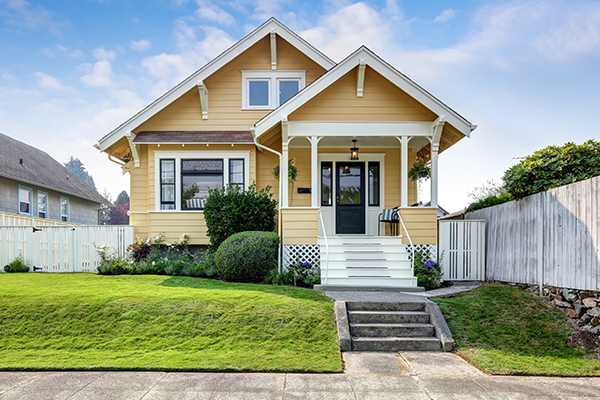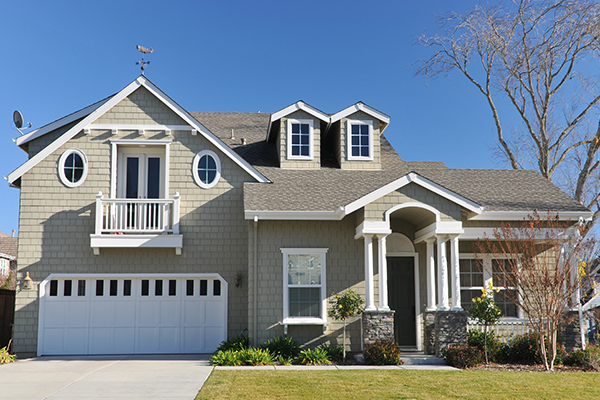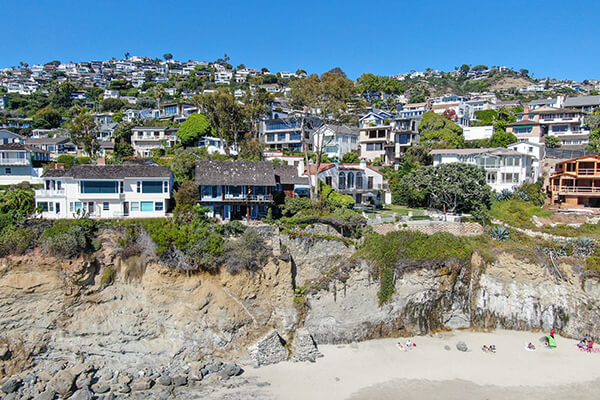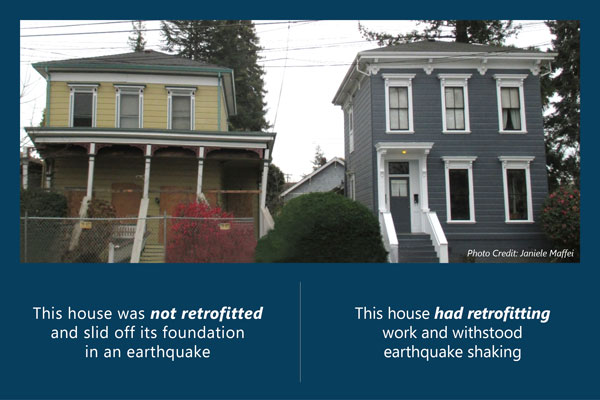Earthquake retrofitting involves strengthening a structure to make it more resistant to earthquake shaking and damage.
Do you know if your house can stand the rocking and rolling from a major earthquake? There are over one million vulnerable older homes in high hazard earthquake areas in California—in other words, homes that could experience significant damage or destruction during a major earthquake. Many older homes were built before modern building codes were in place to help protect against quakes; other homes are more vulnerable to shake damage because of their design.
Whether you live in Los Angeles, San Francisco, or any other part of California, learn how to strengthen your home! Properly bracing and bolting your house’s foundation, known as seismic retrofitting, can help you avoid expensive structural repairs and personal injury to you and your loved ones. Discover if your house needs shoring up. Investing a small amount of money in the cost of retrofits today may help reduce steep expenses to repair earthquake damage to your home.
What types of homes may need a seismic retrofit?
Millions of homes in California are wood-framed houses that need a brace and bolt retrofit in order to prevent them from sliding off their foundation. But many other types of homes are also vulnerable to shake damage, for different reasons.
Review your house type or hazard below to learn about its vulnerabilities, and what you can do to strengthen your property against earthquake damage.
Raised Foundation Houses
Older houses with steps up to the first floor are on a raised foundation. This means they have an area underneath the first floor, which is referred to as a crawl space. These types of houses can shift off their foundations from shaking. They can often be strengthened by bolting the house to its foundation with anchor bolts, or with bracing and bolting.
Learn more about foundation bolting and bracing, and how to strengthen a raised foundation house.
Stem-Wall Houses
“Stem-wall” houses are also a type of raised foundation house, and also risk having the house slide off its foundation from earthquake shaking. These types of houses have a wood-framed first floor, which rests directly on a raised perimeter concrete foundation. The stem-wall retrofit consists of bolting the house sill plate to the foundation using foundation plates.
Learn more about how to strengthen a stem-wall house.
Cripple-Wall Houses
Cripple-wall (“crawl space”) houses also have raised foundations with a crawl space under the house, with short (less than full-story height) wood-framed walls between the foundation and the wood-framed first floor. These types of houses would benefit from a brace and bolt retrofit, which includes bracing of the walls as well.
Learn more about how to strengthen a cripple-wall house.
Post & Pier Houses
A post and pier house also has a raised foundation, but the wood frame floor is supported only by upright wood posts. The posts rest on individual concrete blocks or pier pads around the perimeter and interior of the crawl space. Without a continuous perimeter foundation, the house can shift or collapse in an earthquake. Adding a foundation that is braced and bolted will strengthen the house.
Learn more about how to strengthen a post and pier house.
Houses with a living space over a garage
Houses built with one or more floors of living space over a garage attached to the house are vulnerable to damage from earthquakes because the walls and door(s) are not often reinforced for shaking. These are often called "soft story" residences. Retrofitting the garage space can make it more resistant to earthquakes.
Learn more about how to strengthen a house with a living space over a garage.
Hillside Houses
Houses built on hillsides or steep slopes are often set on tall, narrow posts or columns, with walls stepping down the hill. The foundation is often expected to bear the weight of the entire house—but the structural elements found in these types of houses are not designed to be able to withstand shaking. Retrofitting often includes foundation strengthening and wall bracing and bolting.
Learn more about how to strengthen hillside houses.
Why is seismic retrofitting done?
Safeguard the investment you have in your home with seismic retrofitting. The benefits of retrofits are threefold:
- Increasing your safety.
- Protecting your investment in your home.
- Helping you to stay in your home after a damaging earthquake.
Increasing Your Safety
Strengthening your home with a seismic retrofit can lessen your risk of personal injury. The less shaking your fine china, appliances, and other possessions are subjected to, the better. By securing appliances and heavy furniture, and bolting your foundation, you will more likely be able to safely ride out the next major earthquake.
Financially Protecting Your Investment
A seismic retrofit lowers your risk of damage due to a major earthquake. If your house does experience damage, the level of damage is likely to be reduced. Building costs can be expensive so, in the long run, investing in earthquake resistance by retrofitting your home can save you money.
Ensuring You Have a Place to Live
More than 16,000 housing units in the greater San Francisco Bay Area were deemed uninhabitable (defined as unable to be occupied due to structural problems), leaving people unable to return to their homes, after the Loma Prieta earthquake in 1989. By strengthening your house, you are likely to experience fewer earthquake-related damages. A properly retrofitted house could also make it easier to stay in your home after a major quake occurs.
How do you retrofit a house for earthquakes?
A seismic retrofit involves strengthening the house’s foundation to make it more resistant to earthquake shaking and damage. Depending on the house type, the “how” may involve adding plywood to crawl space walls, using bolts to secure the foundation, or in some cases adding a foundation or other strengthening and mitigating elements.
An earthquake’s shaking motion can cause severe damage to older homes. At risk are homes built before 1980 with raised foundations because many were not built to resist shaking and moving.
The major benefit of a seismic retrofit is it will keep your house from being displaced from its foundation. This makes the building safer and less prone to major structural damage during an earthquake.
The 2014 South Napa magnitude 6.0 earthquake was the largest quake in the San Francisco Bay Area since the 1989 Loma Prieta earthquake.
Houses in Napa shook violently, but two houses that sat side-by-side had different loss experiences. One stood intact; its neighbor had shifted off its foundation with dramatic structural harm. Guess which one was seismically retrofitted?
How much does an earthquake retrofit cost?
The cost of a retrofit can vary. While there isn't a standard cost for earthquake retrofitting a home, most brace and bolt types of retrofits range from $3,000 to $7,000.
By spending less than $7,000 on a retrofit to strengthen your house now, you can reduce earthquake damage to your house and save six figures in disaster repairs.
The cost of a retrofit protects your house against future earthquake damage. Keep in mind that after a retrofit, your costs are likely to be a lot less compared to after a devastating earthquake, which can displace you from your home and requires serious repairs.
Learn more about retrofitting costs and to see if you are eligible for assistance.
Is a seismic retrofit really worth it?
An earthquake retrofit keeps your home on its foundation. What is an earthquake retrofit? Seismic retrofitting includes bracing, bolting and reinforcing your home’s foundation, walls, roof and chimney to resist earthquake shaking.
A retrofit is worth it because it will strengthen your house against shake damage, ease worry and help you be safer and more prepared!
Learn more about your house type and how to strengthen your house against earthquake damage.
How long does it take to retrofit a home?
A simple retrofit may only take a few days of work, and in almost all instances workers never need to come inside your house. However, it is important to plan properly and allow time to choose a contractor, and allow for permitting and approvals. The entire project, from planning to completion may take 4 -12 weeks, depending on the scope of work.
Now is the time to protect your house against earthquake. Many homeowners with a verified retrofit say that they are pleased with the result—and it gives them one less thing to worry about! The long term benefits outweigh the temporary inconvenience of a construction project.
How else you can mitigate earthquake damage?
To reduce the risk of personal injuries and safeguard your house against earthquakes follow the Essential Steps to Earthquake Safety.
- Practice Drop, Cover, and Hold On with members of your household.
- Identify safe places in your house.
- Purchase or make an earthquake safety kit.
- Discover if your home needs bracing and bolting.
Enjoy the benefits of a seismic retrofit and preparing your home against earthquake shaking and damage.
Strengthen your home!
You don't have to have a degree in structural engineering to be ready for the next powerful earthquake. Identify and fortify your home’s vulnerability against this risk. California is earthquake country. Join the thousands of people who have already discovered the benefits of a retrofit and strengthen your house today.





